
|
The nation's economic condition took a turn for the worse in 1937, and the last strands to which the LSE had been clinging were fraying. The company's freight handlers, who had suffered pay cuts and been dissuaded from striking in previous years, could abide no more. On May 15, 1937 they went on strike in protest of their substandard wages. Unfortunately, the company couldn't do anything about wages nor endure a disruption of freight. The end had come. Fred Coen stated to newspapers that the decision to end freight was based on the increasing costs of doing business, and denied that labor unrest was the cause. In either case, all freight service ended immediately, nearly 150 jobs were cut, and the necessary arrangements to replace rail service with buses were begun. Passenger cars had long used the Eagle Ave. depot as a layover site, and since the closure of the Kingsbury Run Viaduct they were the only interurban cars to be seen there. But on May 1, 1938, all passenger car layovers were redirected to the East 9th Street pier so demolition of the freight depots could began. Once the buildings were, gone the property was used as parking lots. The takeover of the automobile had become complete. The only interurban building on Eagle Ave. to survive was the NOT&L outbound depot built in 1923. It was acquired by the postal service in 1935 with plans to convert it to a post office garage. The plan was never implemented, and dropped completely during WWII. For many years the building was rented to Roadway Express for use as a truck depot. In 1951 it became a postal service annex. By the 1970's it had become a Coast Guard exchange grocery store. The building finally succumbed to the wrecking ball in 1987, when the entire area was cleared for future construction of Jacob's Field, now Progressive Field. And with that, the last trace of the interurban freight business disappeared from Cleveland's landscape. Ghosts & Survivors Most of the rolling stock which had once frequented the freight depots met a different fate, which has allowed a few to survive. Most freight cars were stored in 1937 when freight operations stopped. A few were put back into use as work cars to dismantle the line in 1938-1939. Like many of the passenger coaches, they were then stripped of their running gear and electrical equipment and sold for use as storage sheds, cottages, and whatever other use they could be converted to. A few even became homes. For decades after the end of the Lake Shore Electric, these cars could still be found scattered across northern Ohio. Many were eventually demolished, or simply rotted away. A few managed to survive, however, and in recent years have been purchased for preservation and restoration. A few notable examples are discussed below and in the photos. Box motors 28 and 29, two Barney & Smith cars built in 1900 for the TF&N and converted to freight motors in the 1920's, were purchased in July 1938 and incorporated into the structure of a barn outside Sandusky, where they remain today. Freight motor 46 was sold to Leroy Benzinger of Venice, Ohio in December 1938, and remained in good care for fifty-one years. In October 1989, it was acquired by the Mad River & NKP Railroad Museum of Bellevue and moved to their restoration barn. As of 2015 it has received a partial exterior restoration and is awaiting completion. Steel box motor 38, built by the LSE Sandusky shops in 1920, was put to use as an office and storage shed at the Vermilion Hunt Club in 1938, where it remained for 70 years. In 2008 the very well-preserved car body was purchased by LSE enthusiast Thomas Patton who plans to restore it. Sister freight motor 39 has endured multiple moves and the ravages of nature. First hauled to Ruggles Beach in 1938, it was later used as a bait shop and boat livery next to the river in Vermilion. It was caught in a severe flood on July 4, 1969, and shortly after was purchased by LSE enthusiast Ron Jedlicka, who moved it to his property near Homerville. As of this writing, it remains there and is being offered for sale. Box motor 42 was originally a passenger car built by the Niles company in 1907, but converted to a freight motor in 1929. It too spent decades as a well-maintained storage shed, this time near the "Slate Cut" in Sandusky. In 1998 it was purchased by the Northern Ohio Railway Museum and moved to the museum grounds near Chippewa Lake for future restoration. NORM also owns two box trailers: LSE 464, one of the early trailers built in 1919 featuring end doors for hauling automobiles, and a Cleveland Southwestern trailer. Box trailer 810, a former Michigan Railway car purchased by the LSE in 1929, has survived despite being used as a hog shed for decades outside Sandusky. It was acquired by the Illinois Railway Museum in 1984 and has been treated to an impressive comprehensive restoration in recent years. Sister trailer 808 was not so fortunate. It had severely decayed after many years as a storage shed and was demolished around 2010. The interurban freight business once thrived in Cleveland, helping to improve the lives of both city residents and those in the surrounding communities and countryside. Today few people know it ever existed. Thankfully, enough documentation (and even some of the cars) exists that one can still explore its history, retrace the steps, and visit the locations, even if a hefty dose of imagination is required to see it as it once was. |
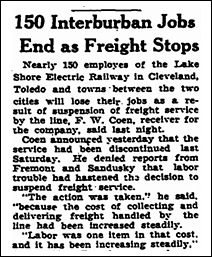
the suspension of LSE freight. (Plain Dealer) |
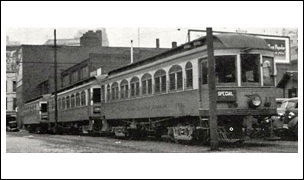
Here three coaches wait for the call to commuter duty at Public Square. (Harry Christiansen) |
|
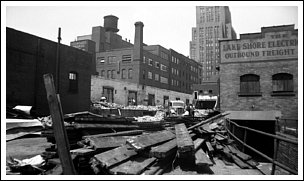
1938, just before all rail operations ended. (Dennis Lamont) |
|

EPA depot comes down, just out of frame to the left. (John Rehor) |
|

depot in early 1938. (Louis Szakacs photo) |
|

(Dennis Lamont photo) |
|

probably sometime in the 1930's. (Drew Penfield) |

(Dennis Lamont photo) |
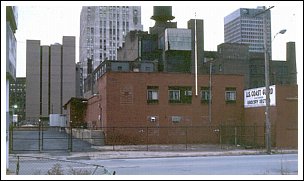
a truck depot, mail facility, and was a Coast Guard exchange grocery store in 1978. (Dennis Lamont photo) |
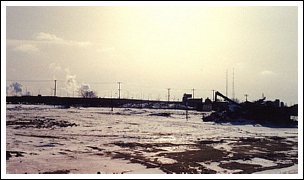
entire area was cleared to build a baseball stadium. (flickr.com) |

in 1992 and the park opened in April 1994. (wallpaperweb.org) |

still stand as a reference point for the depot locations. (flickr.com) |

Sandusky from 1938 until sometime in the 1980's. (Jim Semon photo) |

was also repurposed at Buckeye Tire. (Jim Semon photo) |

and well protected inside a barn near Sandusky. (Jim Mihalek photo) |
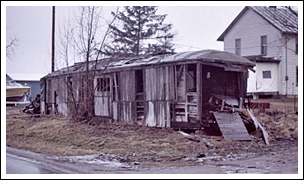
It was demolished sometime after this photo was taken in 1990. (Jim Mihalek photo) |
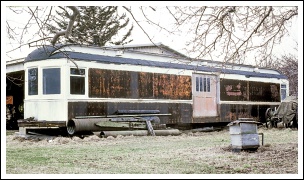
zinger near Venice, Ohio. It now awaits restoration in Bellevue. (Jim Semon photo) |
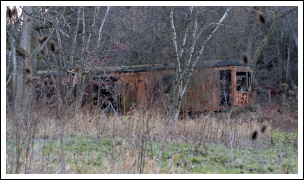
exists near Homerville as of 2015. (Jim Mihalek photo) |
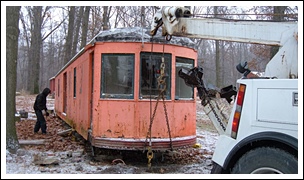
Club after 70 years, and today is awaiting restoration. (Dennis Lamont photo) |
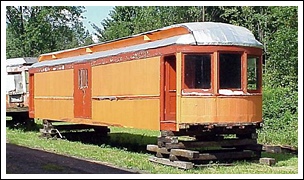
in 1998. It awaits restoration near Chippewa Lake. (Northern Ohio Railway Museum) |
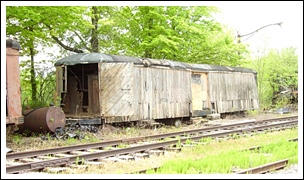
trailers from 1919, it featured end doors for hauling automobiles. (Northern Ohio Railway Museum) |
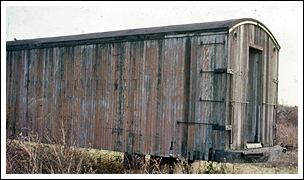
outside Elyria, seen here in 1978. The trailer no longer exists. (Dennis Lamont photo)) |
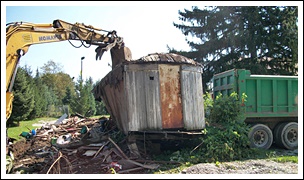
1938, but was recently demolished after years of decay. (Dennis Lamont photo) |
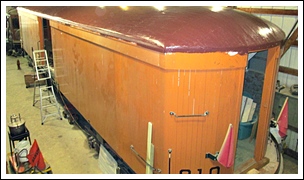
survivors, and the only trailer to have been restored. (Illinois Railway Museum) |
|
|
|